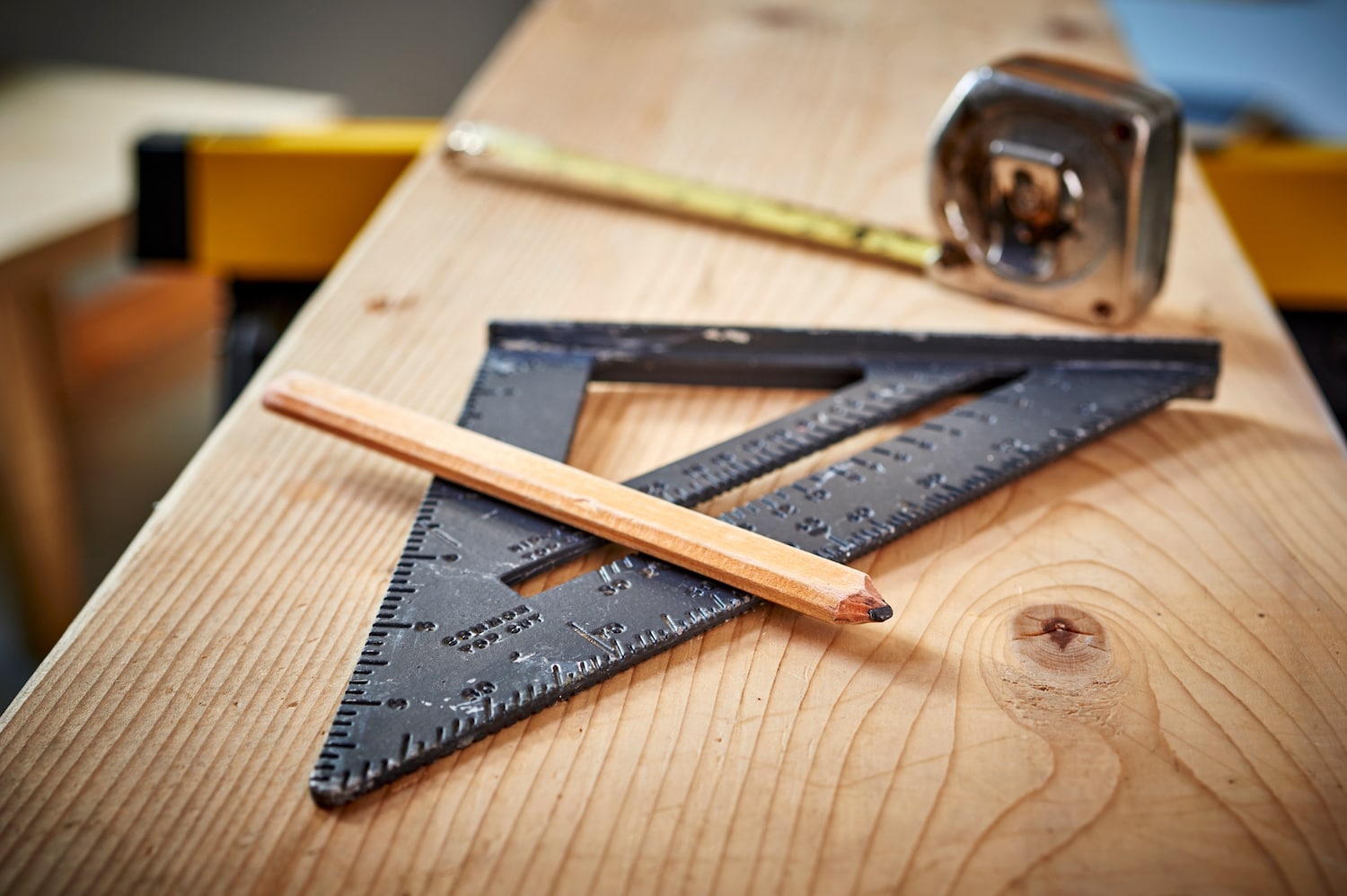
DIY Guide: 10 Tools You’ll Need to Build a Deck
Decks are a big project for any DIYer, so having all of the tools and materials you need from the beginning can save you time and headaches.
Most experienced DIYers may already have a well-stocked toolkit in the garage, but decks often require special equipment. To help you before you get started, we’ve put together a list of some of the most common tools needed to plan, construct, and finish a home deck in your backyard.
Click to jump to a section:
Protection & Planning Tools
1. Protection Equipment
Building a deck requires handling power tools, caustic substances, and other hazards. Always keep yourself safe by using the correct protection equipment for the job.
- Eye protection. Wear goggles or safety glasses to protect your eyes from sawdust, stray nails, and other dangers.
- Gloves. We recommend wearing nitrile-coated gloves to secure your grip and protect your hands.
- Dust masks. A mask keeps you from inhaling sawdust
- Ear protection. Anytime you use power tools, remember to use over-the-ear earmuffs or foam earplugs to keep your hearing safe.
2. Measuring Tools
From start to finish, your measuring tape is going to be your best friend. Each board must be measured and marked before cutting, so make sure you have a quality tape measure you won’t mind using over and over again.
- Measuring tape(s)
- Masonry string or twine
- Pencils, chalk, and/or masking tape
And remember: measure twice, cut once. Save yourself a headache by double-checking and writing down measurements, rather than relying on guesses or your memory.
3. Carpenter’s Level
A sturdy carpenter’s level is a must-have tool to keep your boards straight as you build. You may already have a small level in your toolbox for hanging up picture frames in your home, but a 2 ft. carpenter’s level may be more useful for a deck. You can use a laser level or piece of string to help even out boards in a row, but always use a carpenter’s level to get things started.
Additionally, a water level can be helpful for lining up deck footing if your deck extends into a lake or ocean.
Deck Building Tools
4. Power Drills
You’ll likely need a few types of drills to build a deck in addition to your standard drill driver.
First, a cordless drill driver is a necessity. We recommend at least an 18- or 20-volt electric drill for maximum power and endurance. This versatile tool can be used to pre-drill holes for Ipe and other hardwoods, or drive screws directly into softwoods with ease.
Next, you may want to invest in a mixing drill. These heavy-duty, high-torque tools are designed to thoroughly mix the concrete you need for your deck footings much faster than if you were to mix it by hand. A mixing drill also helps to prevent air pockets from forming and reducing the concrete’s strength.
Impact drivers are another popular choice for some experienced DIYers. Their higher torque and the ability to use different hex accessories allows them to get the job done when used correctly.
5. Circular Saw or Miter Saw
When you’re building something as large as a deck, a hand saw alone just isn’t going to cut it (no pun intended). You’re going to be cutting a lot of boards, so you’ll need to invest in a quality circular saw or miter saw if you don’t already have one
These saws will work with composite decking materials, too. There are even saw blades made specifically for cutting composite and PVC as cleanly as possible.
If you’re not sure what kind of blade you’ll need for your board type, ask an expert here at Decks & Docks.
6. Jigsaw
For more detailed areas, such as the deck’s staircase railing, a cordless jigsaw will allow you to cut around tight spots with ease.
While jigsaws work well for softwoods and composite boards, be aware that you may need to invest in a different blade for exotic high-density hardwoods like Ipe or Garapa. Exotic hardwoods are notoriously hard to cut through with standard blades—so pick up a new carbide blade to fit your saw to ensure sharp, clean edges.
7. Hardware
Hardware (screws, nuts, bolts, and fasteners) will make up the smallest portion of your deck building budget, but a low price doesn’t mean less importance. You could choose the strongest hardwood or the most durable PVC decking material, but without quality hardware to match, your deck won’t be stable for long.
The right hardware will depend on how you build your deck and what materials you use, so here are some general tips to keep in mind:
- Don’t skimp. Spending a little extra on high-quality stainless steel fasteners and screws will ensure your hardware lasts the lifetime of your decking material.
- Make sure the screws you use are compatible with your deck boards. Pressure-treated lumber, for example, requires screws that are ACQ (Alkaline Copper Quaternary) compatible to prevent corrosion.
- Hidden fasteners are a popular installment option that leave no visible screws on the deck’s surface. Our experts can help you choose the right type of fastening hardware for your specific decking material.
Finishing Tools & Supplies
8. Random Orbital Sander
To prep your deck for staining and sealing, we recommend using a random orbital sander. Sanding your deck by hand is a time-intensive task, and heavy-duty sanders can do more harm than good if you aren’t careful. The user-friendly random orbital sander is the best way to get an even result in very little time.
We recommend random orbital sanders over belt sanders because they’re safer and easier to control.
9. Router and/or Sandpaper
A router can help smooth the edges on railing or on corners that a random orbital sander is too large for. Routers can also carve decorative touches around the edges of your deck.
You can also use sandpaper if you want to put a little elbow grease into finishing your deck. Choosing the right sandpaper is just as important as choosing the right sanding tool. A two-step approach will yield the best results. First, gently sand your deck with a coarse 60- or 80-grit sandpaper. On your second pass, use finer 100-grit sandpaper to create an extra-smooth finish.
Of course, the right sandpaper grit also depends on the type of wood you use. Talk to your decking supplier to find out which grit will work best for you.
10. Stain & Sealant
If you’re using composite decking, your deck is ready to use after installation. On the other hand, organic lumber requires a stain to add color and a sealant to protect the wood.
The stain you choose will depend on the type of lumber you’re using and your personal style preference. For a sealant, choose one made specifically for outdoor use on decks. Your sealant is your deck’s first line of defense against rain, snow, insects, and everything else Mother Nature has to offer—so make your choice count.
Both stain and sealant will take a couple hours to apply (depending on the size of your deck) and at least 1-2 days each to dry and cure. Paint brushes and sponges are great for evenly applying stain on small-to-medium sizes decks, but you may want to consider a paint roller for larger areas.
Any Questions? Let Us Help
At Decks & Docks, we aim to be your one-stop shop for all things related to decking. If you want to pick up some lumber, figure out what hardware you’ll need, or just get some advice from a decking expert, trust Decks & Docks.
You can visit your nearest Decks & Docks location or drop us a line at any time.
- About the Author
- Latest Posts
Dan has worked for Decks and Docks for over twenty-five years. He managed the original Decks and Docks store in St. Pete, which is our largest store. Dan is simply the best all around. He knows more about this company and our products than probably anyone else. Dan currently works in Sales at our corporate office.
